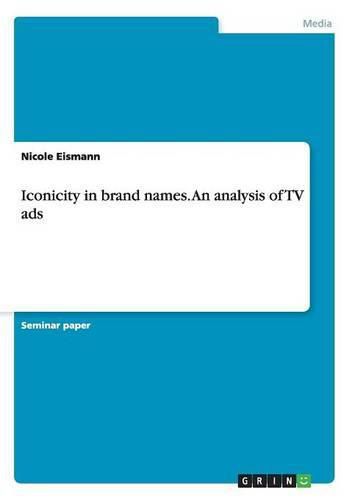Readings Newsletter
Become a Readings Member to make your shopping experience even easier.
Sign in or sign up for free!
You’re not far away from qualifying for FREE standard shipping within Australia
You’ve qualified for FREE standard shipping within Australia
The cart is loading…






Seminar paper from the year 2013 in the subject Communications - Public Relations, Advertising, Marketing, Social Media, grade: 2.3, University of Bonn (Institut fur Anglistik, Amerikanistik und Keltologie), course: Issues in Linguistic: Semantics, language: English, abstract: Do brand names have an iconic function, or are they rather arbitrary, just like Saussure claimed concerning linguistic signs in general? And if they have an iconic function, does the iconicity of brand names serve its purpose, i.e. do the icons transport the connotation they are supposed to? These questions are going to be answered in this paper with the single focus on phonetic phenomena. Linguistics and semiotics still labor under the shadow of Saussure (1916), even though throughout the 20th century there have been repeated demonstrations that arbitrariness is quite limited . With this statement, Waugh (1992:7) gets to the heart of a problem which is by far not new but still current. While Saussure worked out the relationship between ‘signified’ and ‘signifier’, i.e. between an object and its sign, as arbitrary and therefore totally insignificant, no small number of scientists back the assumption that there are indeed certain meanings behind morphological and phonetic symbols, what builds the base for the entire study of iconicity. Iconicity itself is defined as the connection between an object and its linguistic sign, which is called an ‘icon’ or ‘iconic sign’ if the relationship between this object and its sign depends on similarity […] or on some relation analogous to similarity (Hilpinen 2012:267). An icon might include a proper description of the object and therefore transport a certain denotation for exactly this object. This paper, however, makes brands and their iconic (or non-iconic) names a subject of discussion. Brand names are, for certain reasons, by no means denotations, i.e. they do not ‘describe’ the object, but are supposed to transport a meaning which is of importance
$9.00 standard shipping within Australia
FREE standard shipping within Australia for orders over $100.00
Express & International shipping calculated at checkout
Seminar paper from the year 2013 in the subject Communications - Public Relations, Advertising, Marketing, Social Media, grade: 2.3, University of Bonn (Institut fur Anglistik, Amerikanistik und Keltologie), course: Issues in Linguistic: Semantics, language: English, abstract: Do brand names have an iconic function, or are they rather arbitrary, just like Saussure claimed concerning linguistic signs in general? And if they have an iconic function, does the iconicity of brand names serve its purpose, i.e. do the icons transport the connotation they are supposed to? These questions are going to be answered in this paper with the single focus on phonetic phenomena. Linguistics and semiotics still labor under the shadow of Saussure (1916), even though throughout the 20th century there have been repeated demonstrations that arbitrariness is quite limited . With this statement, Waugh (1992:7) gets to the heart of a problem which is by far not new but still current. While Saussure worked out the relationship between ‘signified’ and ‘signifier’, i.e. between an object and its sign, as arbitrary and therefore totally insignificant, no small number of scientists back the assumption that there are indeed certain meanings behind morphological and phonetic symbols, what builds the base for the entire study of iconicity. Iconicity itself is defined as the connection between an object and its linguistic sign, which is called an ‘icon’ or ‘iconic sign’ if the relationship between this object and its sign depends on similarity […] or on some relation analogous to similarity (Hilpinen 2012:267). An icon might include a proper description of the object and therefore transport a certain denotation for exactly this object. This paper, however, makes brands and their iconic (or non-iconic) names a subject of discussion. Brand names are, for certain reasons, by no means denotations, i.e. they do not ‘describe’ the object, but are supposed to transport a meaning which is of importance